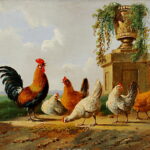
Easter is on April 4, just under two weeks away. Will this be the year you attempt to create pysanky?
Pysanky refers to eggs inscribed by an artist using a stylus that imparts the design in beeswax. The eggs may be chicken, duck, goose, or even ostritch. Some artists leave the egg intact with the yolk and white inside. Over time, the egg’s contents should dry up. The down side of this methods is that the eggs can explode under heat pressue which both destroys the design and emits an unpleasant odor.
The alternative is to “blow out” the egg first. Pierce a hole in opposite ends of the egg, and literally blow out the inside of the egg. This is both time-consuming and exhausting. As a child I once blew out an egg. That was enough for me.
There’s another reason to keep the egg intact as well as keeping a rooster among the hens. The eggs used for pysanky must be fertilized so that the home is blessed with fertility.
Like many Easter customs, the art of Ukranian pysanky predates Christianity. People worshiped a sun god known as Dazhboh who chose birds for his companions. Humans could not catch the birds, but they could gather the eggs.

Fun Fact: Chickens need 14 hours of light to produce eggs so they don’t lay very well in the winter months. They also prefer temperatures between 45 degrees F and 75 degrees F. This is why hens begin laying more eggs in the spring when warmth and life return to the earth.
Traditionally, women began to gather eggs they judged appropriate, on the basis of their size and shell thickness, in the middle of Lent, or about 2 weeks before Easter.

Women also produced dyes made from dried plants, roots, insects, and bark. For example, yellow from woadwaxen, gold from onion skins; red from cochineal, and black from walnut husks.
Artists created the designs using a sylus called the pysachok, with which they used beeswax to “write” the design on the egg.
Before Christianity, designs emphasized elements of nature. A triangle could mean the trilogy of air-fire-water; the cycle of life: birth-life-death; or a family unit. Modern Christian symbolism sees the Holy Trinity within the triangle.

Curls and spirals are for defense. Dots may represent seeds, stars or cuckoo bird eggs. Or simply the Virgin Mary’s tears.
Creating pysanda is an intricate process, as depicted in this 20-minute how-to video by Miss Justina Marie.
So what do you think? Will you try making pysanky this year?
🥚🥚🥚
Illustrations
Pysachok by Luba Petrusha
Chickens & a Park Vase by Albertus Verhoesen
Variety of styluses by Lubap
Basket of pysanky by Lubap

Sandra Wagner-Wright holds the doctoral degree in history and taught women’s and global history at the University of Hawai`i. Sandra travels for her research, most recently to Salem, Massachusetts, the setting of her new Salem Stories series. She also enjoys traveling for new experiences. Recent trips include Antarctica and a river cruise on the Rhine from Amsterdam to Basel.
Sandra particularly likes writing about strong women who make a difference. She lives in Hilo, Hawai`i with her family and writes a blog relating to history, travel, and the idiosyncrasies of life.

